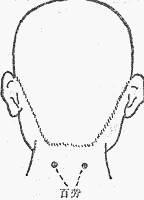| acupoint | Bailao |
extra point.
bubble_chart Etymology
Strain, strain, pulmonary tuberculosis. This point can treat pulmonary tuberculosis (pulmonary tuberculosis) and cervical lymph node. The point is on the neck, hence the name Jingbailao (EX-HN15).

There are trapezius and splenius capitis muscles; there are occipital artery, vein and vertebral artery and vein; there are branches of the greater occipital nerve and the lesser occipital nerve.
Perpendicular insertion or oblique insertion 0.5~1 cun. Can be used for moxibustion.
Scrofula, laozhen, cough, panting, whooping cough, nape wind-dampness pain, bone steaming hot flashes, night sweating, insomnia, epistaxis, allergic rhinitis.
- insomnia: Bailao (double).
- epistaxis: Bailao (double).
- Allergic rhinitis: Drug application method during the dog days, first apply Bailao, Feishu (BL13), Gaohuangshu ( BL43); middle-position Dazhui (GV14), Fengmen (BL12), Pishu (BL20); end-position Dazhu (BL11), Feishu (BL13), Shenshu (BL23).
- scrofula: neck Bailao (moxibustion), Zhoujian (EX-UE1) (moxibustion), initial supranuclear treatment (acupuncture first, then moxibustion).
The Bailao point was first seen in Zhenjiu Zisheng Jing in the Song Dynasty, but it has no location; in the Ming Dynasty, Zhenjiu Daquan said: "It is the Dazhui (GV14) point". In modern times, the cun next to Dazhui (GV14) was also called Bailao, with the nickname Bailao. Together with this point, it is called the "Four Bailao Points".






